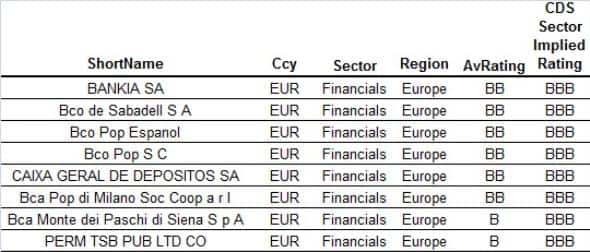Customer Logins
Obtain the data you need to make the most informed decisions by accessing our extensive portfolio of information, analytics, and expertise. Sign in to the product or service center of your choice.
Customer Logins
CREDIT COMMENTARY
Nov 25, 2015
Financials go into 2016 on improving foundations
Bank credit spreads have tightened on the back of lower than expected TLAC requirements, with the financial sector looking sturdier than non-financials going forward into 2016.
- Spread difference between US financials and non-financials at its most negative since 2006
- Since July, US financials have outperformed non-financials by 1.4% on a total return basis
- European CDS spreads imply periphery banks may be due for a ratings upgrade
Earlier this month the Financial Stability Board (FSB) issued its final minimum total loss absorbing capacity (TLAC) requirement for banks deemed systemically important to the global economy. The regulation aims to prevent the collapse of banks deemed to be too big to fail. The proposals set were lower than expected on both minimum debt and total TLAC requirements.

Bank spreads reacted positively to the TLAC news with the Markit iBoxx $ Domestic Financials index having tightened 6bps so far this month. Conversely, the iBoxx $ Domestic Non-Financials has tightened 2bps. The spread difference (basis) between the two indices now stands at -41bps, 17bps wider this year and the most negative level since 2006 as financial credit continues to improve. Strong regulatory oversight coupled with a stronger economic backdrop since 2013 has meant financials have ridden bouts of macro volatility better than non-financials.

In terms of bank capital, senior debt, as represented by the Markit iBoxx $ Domestic Banks Senior index, has tightened 10bps this month while subordinated debt, as represented by the Markit iBoxx $ Domestic Banks Subordinated index tightened just 3bps. This sent the basis between the two indices wider to 85bps at the higher end of recent range bound trend.
2016 outlook
This trend is also reflected in the returns delivered by financials bonds over the rest of the investment grade universe.

Since July, financials have outperformed non-financials by 1.4% on a total return basis, a period of market turbulence. The reliance of the financial sector amid this market volatility may prove to be fruitful for defensive investors expecting further bouts of volatility in 2016. The Markit iBoxx $ Domestic Financials index spread remains 23bps wider than 2015's lows in March.
Other factors that could work in favour of financials over non financials in 2016 include bond supply. M&A activity among corporates, and the need to raise debt to fund these deals, has seen the overall corporate world become increasingly leveraged. Financials on the other hand have been actively deleveraging since 2008 in order to meet the increased scrutiny brought on by balance sheet regulation. The potential for divergence in supply could impact spreads from a technical standpoint. The pending US interest rate hike, and the subsequent pace of hikes could also prove beneficial for bank credit, as net interest margins, a key industry revenue driver, improve.
Spanish and Italian banks
In Europe, continued deleveraging has led to stronger fundamentals, especially in banks that primarily operate in Europe's periphery.

According to Markit's CDS pricing service, implied CDS ratings show several Spanish and Italian banks are not deserving of their current "junk" credit ratings. The impact of official rating changes could help credit spreads improve in Europe's banking sector.
Neil Mehta | Analyst, Fixed Income, Markit
Tel: +44 207 260 2298
Neil.Mehta@markit.com
S&P Global provides industry-leading data, software and technology platforms and managed services to tackle some of the most difficult challenges in financial markets. We help our customers better understand complicated markets, reduce risk, operate more efficiently and comply with financial regulation.
This article was published by S&P Global Market Intelligence and not by S&P Global Ratings, which is a separately managed division of S&P Global.
{"items" : [
{"name":"share","enabled":true,"desc":"<strong>Share</strong>","mobdesc":"Share","options":[ {"name":"facebook","url":"https://www.facebook.com/sharer.php?u=http%3a%2f%2fwww.spglobal.com%2fmarketintelligence%2fen%2fmi%2fresearch-analysis%2f25112015-Credit-Financials-go-into-2016-on-improving-foundations.html","enabled":true},{"name":"twitter","url":"https://twitter.com/intent/tweet?url=http%3a%2f%2fwww.spglobal.com%2fmarketintelligence%2fen%2fmi%2fresearch-analysis%2f25112015-Credit-Financials-go-into-2016-on-improving-foundations.html&text=Financials+go+into+2016+on+improving+foundations","enabled":true},{"name":"linkedin","url":"https://www.linkedin.com/sharing/share-offsite/?url=http%3a%2f%2fwww.spglobal.com%2fmarketintelligence%2fen%2fmi%2fresearch-analysis%2f25112015-Credit-Financials-go-into-2016-on-improving-foundations.html","enabled":true},{"name":"email","url":"?subject=Financials go into 2016 on improving foundations&body=http%3a%2f%2fwww.spglobal.com%2fmarketintelligence%2fen%2fmi%2fresearch-analysis%2f25112015-Credit-Financials-go-into-2016-on-improving-foundations.html","enabled":true},{"name":"whatsapp","url":"https://api.whatsapp.com/send?text=Financials+go+into+2016+on+improving+foundations http%3a%2f%2fwww.spglobal.com%2fmarketintelligence%2fen%2fmi%2fresearch-analysis%2f25112015-Credit-Financials-go-into-2016-on-improving-foundations.html","enabled":true}]}, {"name":"rtt","enabled":true,"mobdesc":"Top"}
]}



